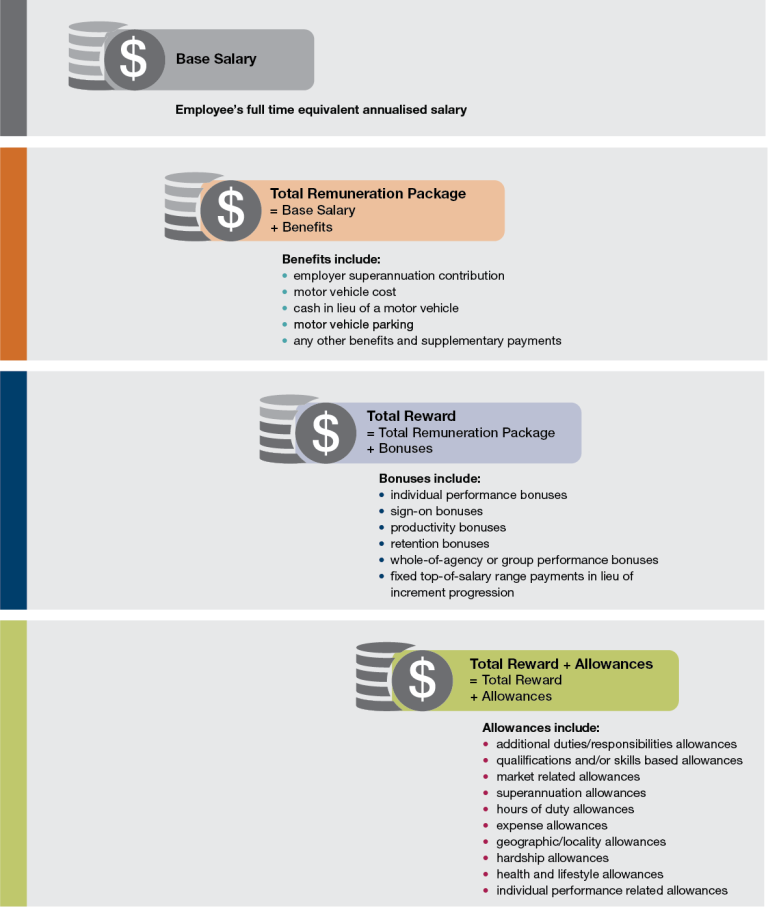Appendix 1: Guide to interpreting the data
Remuneration components
The key remuneration components covered by this data release are Base Salary, Total Remuneration Package, Total Reward and allowances.
Base Salary
Base Salary is an employee’s full time equivalent annualised salary. It includes salary sacrifice amounts such as pre-tax employee superannuation contributions made via salary sacrifice arrangements.
Total Remuneration Package
Total Remuneration Package incorporates Base Salary plus benefits. Benefits include: employer superannuation contribution, motor vehicle cost, cash in lieu of a motor vehicle, motor vehicle parking, personal benefits and other supplementary payments.
Total Reward
Total Reward incorporates Total Remuneration Package (Base Salary plus benefits) plus bonuses. Bonuses include: performance, retention, productivity, sign-on, performance by the employee’s group or whole agency and fixed top-of-salary range payments.
Allowances
Allowances are payments that sit outside of Total Reward as Total Reward plus allowances. They cover payments for working conditions, qualifications and work-related expenses. The availability of, and eligibility for, allowances depends on specific conditions provided under an employee’s employment instrument and particular circumstances of positions.
Figure A.1 Remuneration components

Average
The average is calculated by summing all values and dividing by the total number of values. This is also known as arithmetic average and mean.
Median and weighted median
The median value is the actual midpoint of all values. It is the point for which 50% of values are below and 50% of values are above. Where any set of values has an even number, the median is the average of the two midpoint values.
The weighted median is an adjusted midpoint taking into account the number of employees at each classification. This approach allows for calculation of whole-of-APS, non-SES and SES median percentage changes in remuneration components. The larger the population of a classification or group of classifications the greater impact it will have on the result. Weighted median is an historical measure from successive remuneration reports.
Quartiles
A quartile is a statistical term in which a range of data, ordered from smallest to largest is divided into four equal groups. Each quartile accounts for 25% of the data.
Percentiles
Percentiles mark intervals within the data, in relation to the whole dataset. The 25th and 75th percentiles are referred to as Q1 and Q3 respectively. These intervals are described in the table below.
Table A.1 Percentiles used in this report
|
Percentile point |
Also known as |
Percentage of data |
Percentage of data |
|---|---|---|---|
|
|
|
|
|
|
|
|
|
|
|
|
|
|
|
|
|
|
|
|
|
|
|
|
|
Additional notes on interpreting this data release
- Some columns in the data tables at Appendix 3 may not add up because Total Remuneration Package and Total Reward are calculated separately for each employee. These are the values that determine the median. Therefore median Total Reward is not always the sum of all medians for Base Salary, Total Remuneration Package and Total Reward.
- Data from this release should not be used to calculate past or present populations of the APS. For accurate data as at 31 December 2023, please refer to the 31 December 2023 APS Employment Data Release, which is available from the APSC website.
- Data is analysed and tabulated using several different propriety software packages which may lead to minor variances in data reported between tables. These differences are also evident when trying to recalculate values based on the data in the release in common programs like Microsoft Excel.
- Population data used for analysis in this release is based on data from the APS Remuneration Survey unless stated otherwise. This will differ from published APS Employment Data due to a different collection scope.



